#janekang
Explore tagged Tumblr posts
Text
17. Jane Kang & Francesca Tamse
Jane Kang and Francesca Tamse discuss their work in the context of increased anti-Asian attacks, their recent collaborative project, the relationship between their bodies and their work, and the way their personal histories and cultures play into their practices.

Francesca Tamse (FT): Hi Jane, how are you? I wanted to start out by revisiting our first collaboration nearly a year ago. It was in the Spring of 2021. This was around the time there were several Asian American related attacks taking place across the country. I remember it was a bit of a raw feeling, becoming hyper aware of my body, my identity. We collaborated and took photos of your ceramics, and in retrospect, there was a connection connecting our identities as Asian Americans and our ancestral pasts. Could you reflect more on this time? Also, when constructing your ceramics, one specific piece that comes to mind is the ship and of the mother and child. I found this piece moving.
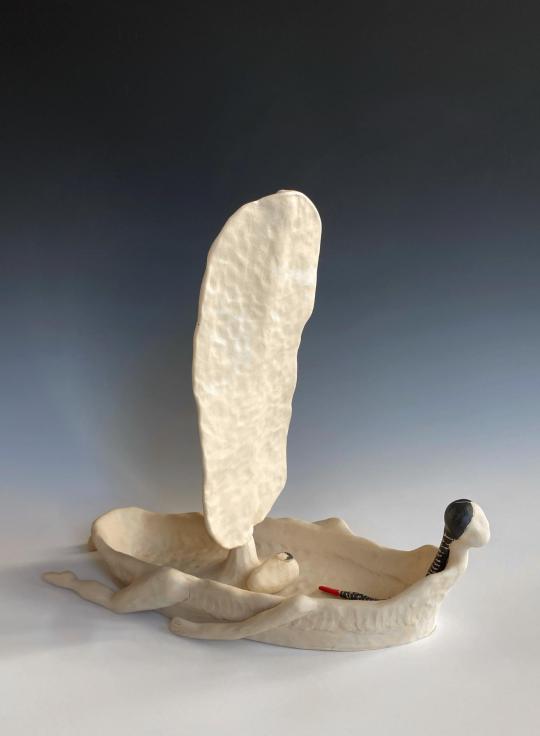
Jane Kang, Body Voyage
Jane Kang (JK): Thank you! I am well, I hope you are too.
I remember that time period vividly. It was a difficult time…between the escalation of attacks on AAPI, along with the extensive quarantine, it was (and sometimes still is) very difficult. Working with another Asian American woman was so special and needed at that time. I remember feeling a tenseness at the beach, quietly worried and feeling a bit exposed. Especially amidst the pandemic, I think you were the first artist I collaborated with in over a year.
As an artist working in the medium of clay, I often contemplate the idea of relics and the mysterious nature of antiquity. Relics are typically construed as quantifying a person’s life or providing contextual evidence of the times.
I developed a strong interest in researching myths and folktales from an early age—maybe because I found the whole cultural schism as an Asian American totally surreal. I also enjoy the notion of myths and folktales being universal, traversing either part of my identity as an Asian or a first generation American.
The world my parents grew up in has always been mysterious and will continue to be. In many ways, the Korea that they knew no longer exists. Their memories and experiences are relics I was raised by, but I didn’t understand why. And so began my ever-evolving theories, my own piecemealed definition of myself and my heritage while living in the contemporary world.
In my work, I implement many of these sentiments, especially matrilineal inheritances. The particular piece you are referring to, Body Voyage, which is loosely based on Goryeo era fishing boats and constructed directly after the shooting in Atlanta, Georgia, I was thinking of chimeras. The word itself means an illusory hope that is nearly impossible to achieve. It is also a Greek mythological female monster with a lion’s head, a goat’s body, and a serpent’s tail. In this piece, I was contemplating the deaths of these women in Atlanta, in particular a woman who strikingly resembled my mother. I imagined a new chimera, a woman who no longer had skin but naked bone in the shape of a boat. She can no longer physically return as the woman who gave birth. Instead, she is only able to look forward as she carries her child, an omniscient, calcified presence with the inability to speak. Much like how many immigrant women may have difficulty communicating with their children or being trapped in a form, finding it nearly impossible to realize their own hopes in exchange for survival.
In regards to your work, what themes do you find recurring? I admire your work with eggs and how much of your work seems to reflect that smooth, delicate texture to the surfaces in your images.
FT: Yes! My obsession with eggs. It became more of a study in my studio one day that cascaded into many iterations of its usage. In relation to surfaces, they photograph so beautifully. Sculpturally smooth, perfected, and requires careful handling. In my practice, I am interested in documenting the masculine body and performing masculinity under a feminine gaze. There is a tension I feel in particular looking back at the Warm Navel photograph. Here, an egg rests on a torso’s belly button.
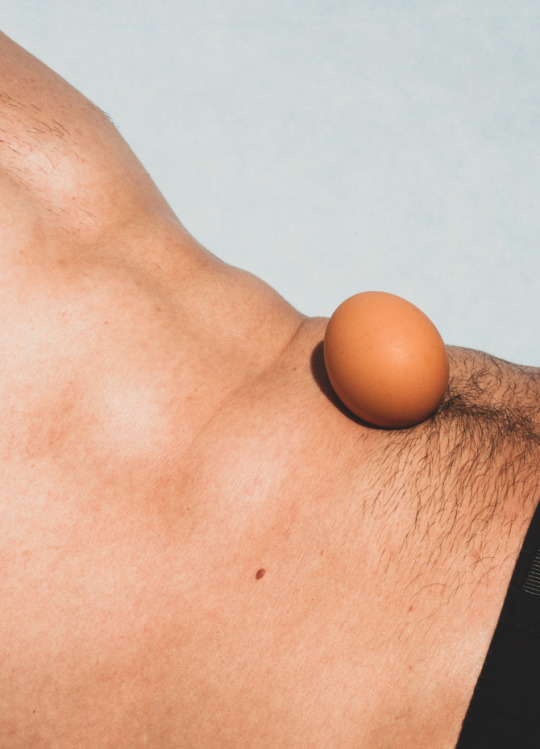
Francesca Tamse, Warm Navel
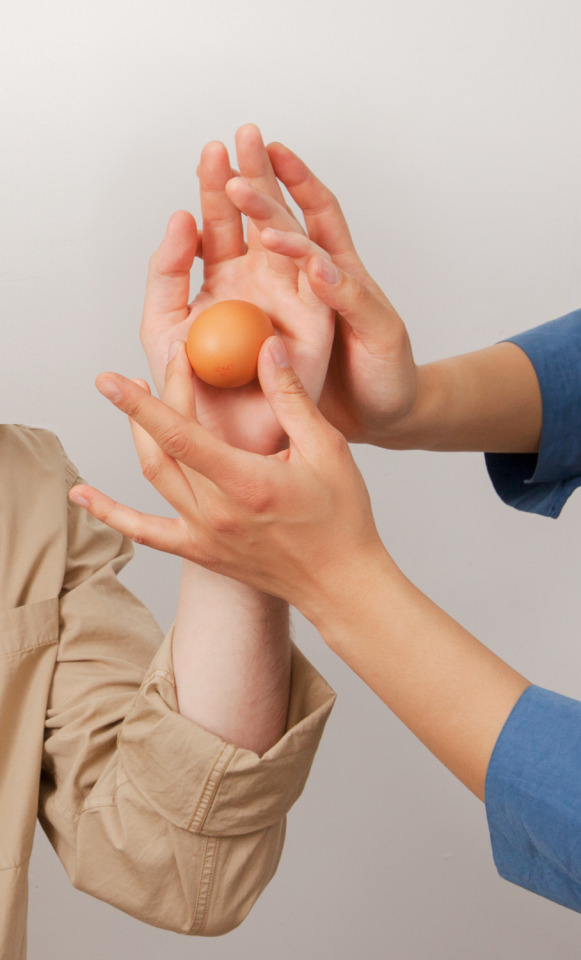
Francesca Tamse
FT: It goes back to the relationship of the uterus and the egg between mother and fetus. Strangely, hands fall into the same category as eggs iconographically. Together, contain power, graceful and spiritual as I hoped to portray in the image.
Egg rituals came into play while working on this subject. The spiritual and healing came into play with these masculine bodies, where I placed my subject into the performance of attempting to ‘heal’ rid of their ‘evils’. This project Spiritualised touches again on violence and bodies which was a reaction to violence and patriarchal systems that exist in society. I liked playing with the pseudoscience of egg rituals as well as poking fun at wellness industry (ahem- Goop’s jade egg); essentially one wants to heal and purify oneself so to speak and have the desire for self care.
Going back to your work, it seemed like such a valuable experience when we did that shoot together, photographing your pieces along the coast. That day felt very solemn, the day looked bleak, but I found it very comforting especially during that time period.
You went into the cold water by impulse, almost ritualistically with your pieces. What was that like for you? What I also enjoyed when photographing was thinking about the materials and components to make your ceramics in relation to the sand, the ocean, the fauna. The photo essay meditates on these feelings.
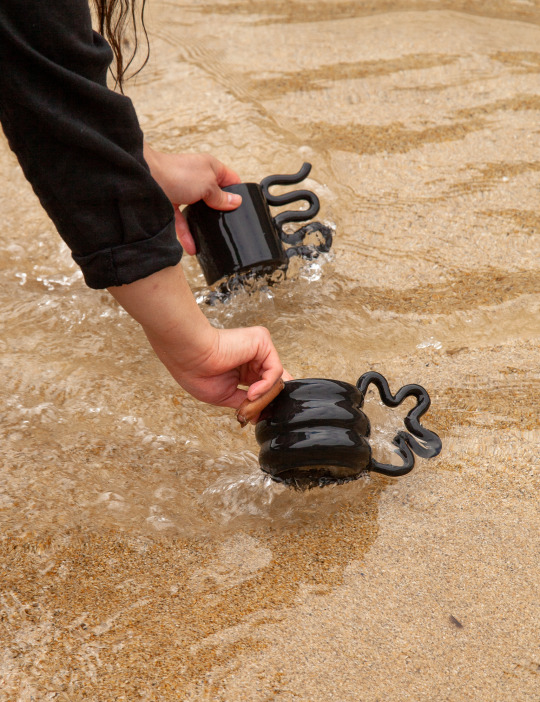
JK: Oh, yeah! The water was very cold, but exhilarating. There was an image from earlier in our shoot that reminded me of The Star tarot card, which depicts a person with one foot on land and another in a pool of water while pouring water onto both. As the cups were being washed over with the water and sand, it did have a hypnotic, rhythmic quality to it. The cups would momentarily be obscured by the oncoming current and reappear with a wet, glossy look. As the wave pulled back, gritty particles of sand fluidly washed over. Then the cycle would repeat.
My pieces felt at home at the shoot. I touched on this in the photo essay, but I’m attracted to liminal spaces, like eclipses and estuaries. Considering ceramics are the culmination of water and earth being blasted by heat that is nearly equivalent to a cremation, it reminds of this quote I love by Pat Barker:
“Cut a chrysalis open, and you will find a rotting caterpillar. What you will never find is that mythical creature, half caterpillar, half butterfly, a fit emblem of the human soul, for those whose cast of mind leads them to seek such emblems. No, the process of transformation consists almost entirely of decay.”
I also loved seeing the final stage of my work framed amongst the factored sum of its own materials. Yet there’s a quiet void that is not acknowledged, the unobservable time when the pieces are in its chrysalis kiln. Finding a living, changing space like a shore line felt like the perfect place for our photo essay.
Additionally, I also find it interesting how the sensation of being cold can be adjacent to pain. There’s a discomfort, a panic to relieve yourself from that feeling. While I was in the water, I found it curious that I was so focused, I didn’t even notice. Normally, I’m actually quite sensitive to the cold.
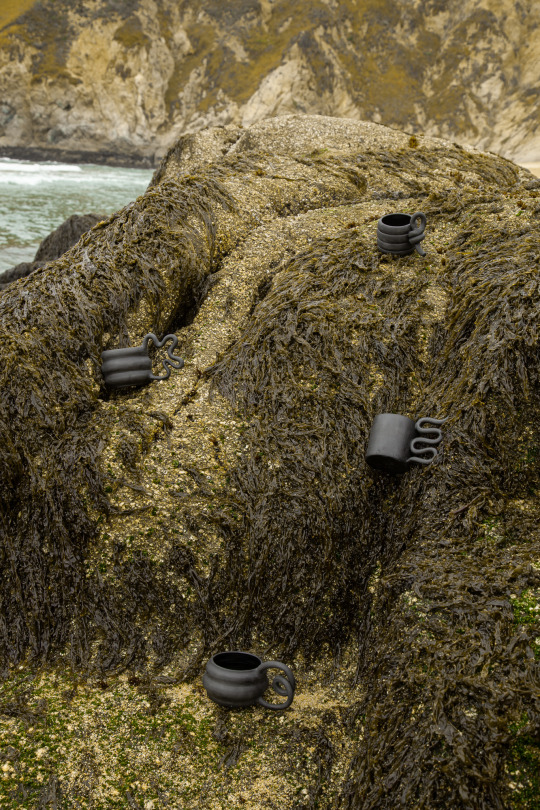
JK: I find that I forget about my own body while I’m working, despite the fact that I depict analogous representations of bodies and faces in sculpture or as vessels. How do you feel about your own body in relation to your work?
FT: With the exception of the latter image where my hands are actually in frame I feel that my body and gaze is implied in the work I make. I usually work with men and offer a prompt or brief to interpret.
I do find myself conscientious of directing their bodies into what may be a vulnerable state. I think there is an understanding in both parties that the work has an irony. That the objectification of the masculine body under a lens was and is dominated by its own gaze unto female bodies historically.
JK: It takes a lot of trust to create the space to make that happen. What do your briefs or prompts typically consist of?
FT: For Spiritualized, I prompted a performance artist, Charlie Ford to create movements that had him carry a sort of burden and weight to the egg. Here you have this object, you are trying to heal yourself of all these toxic events that have existed, almost a self flagellation. I prompted the atrocities of incel attacks as well as a time when a lot of celebrated men were being canceled for their abuse against women.
Separately, warm navel had a close artist friend of mine become comfortable with his own body and not be afraid to get messy around my photographing him. (There were a lot of broken eggs.)
JK: Your reference to egg healing reminds me of Santería—did you have traditions like that in your culture growing up?
FT: Yes, the early research was based on folk medicine and rituals. One in particular was the removal of disease through the navel done in the Philippines through a psychic surgery called “hilot”. Hilot, or massage in this context, refers to searching for disease or illness within a body. I remember the first time I saw this was in “Man On the Moon,”( with Jim Carey as Andy Kaufman) as a child. The depiction of the “witch doctor” performing a ritual onto Kaufman where they were pulling intestines and blood out of his navel, which I found shocking and fantastical.
I would later find out from my parents that this was a recorded hoax. It came out to be a hoax after many of these results ended up being false and took advantage of the vulnerable and those that came to that option as a last resort. It touches again on the wellness industry’s attempt to market what women should do to create mental, spiritual, or physical perfection for themselves. I find that there is a connection between how that controls female bodies to find some kind of solution to a “problem.” This advertising is created under a male gaze which still perpetuates and lingers in this world, while still using feminine bodies.
The egg symbolizes a lot of these thoughts. Images I create based on the egg concept embodies an experience where the spiritual and ritual is assumed to be a transformational healing result. It is a play on these ideas but also attempts to use the egg as an object to “heal” my relationship to the men in my life. Growing up, I’ve had instances where my race and gender were often magnified, being looked at, undermined and see as passive, silent, and sexualized.
Going back to the Pat Barker quote, to think about the in-between latent state of these lamentive pieces that could collapse or flourish in the kiln at any moment. But the pieces feel so alive, almost a memoriam. What do you hope your work communicates to viewers?
JK: My work can currently be categorized in two: my functional pottery and sculpture.
With my functional pottery, I enjoy experimenting with texture and form while maintaining a minimal, simple design style. By quietly focusing on igniting intimacy to everyday objects in the home, the act of nourishing ourselves can become a point of meditation.
Through my sculptural work, I hope to communicate a universal sentiment from the lens of my own personal narrative. There are different thematic elements that reappear such as the role that matriarchs serve in our lives. As a woman, how is this an inheritance that is unintentionally trained in us? How do we love, sacrifice, or survive?
As a Korean-American, I hope viewers can also understand and learn more about the immigrant experience and Korean culture and history. It is a way of connecting to my heritage while expounding on it as a gyopo, which refers to ethnic Koreans who permanently live outside of Korea. By culling elements of folk art, indigenous Korean shamanism, and relics, I hope to achieve a personally established codex that expresses my experience in contemporary environs.
We are still discovering ancient pottery, now monuments to a distant past. Some have survived over 25,000 years. I hope in my practice that my work can offer symbolic perspectives that feel of their time, but also reveal themselves as offerings beyond.

Jane Kang is a ceramicist living and working in San Francisco, California.
www.jane-kang.com www.kang-ceramics.com @kangceramics
Francesca Tamse is an artist and photographer in the San Francisco Bay Area. She received her Masters at the Royal College of Art, London, UK in Photography and BFA Photography at the School of Visual Arts in New York.
tamse.co francescatamse.com @francescatamse
0 notes
Video
instagram
: 갑자기 듣고 싶었다 #개소리 가... 프하하하 Ph. by mini #nerd #pharrell #shewantstomove #janekang #janemuzic #bowwow 아 열난다 빨리 자야지 👀
0 notes
Video
instagram
#janekang #handmade #timelapse #PAstudio : 제인은 재단 중.
1 note
·
View note
Video
instagram
#janekang #janemuzic #camping
0 notes